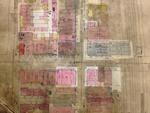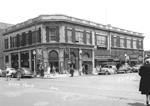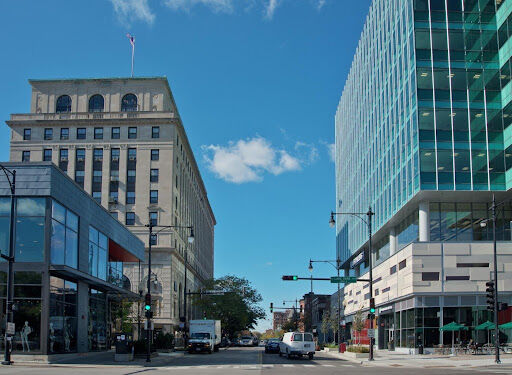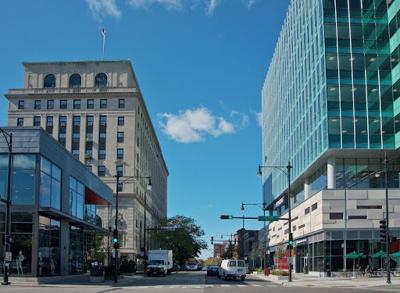Several years ago, the Herald published "Lost Hyde Park," a series of articles by Susan O'Connor Davis, author of "Chicago's Historic Hyde Park," a 2013 book from the University of Chicago Press. Unfortunately, most of the articles were lost when we switched over to a new website last year.
While most of the series is available through our archives, the Herald will also gradually begin republishing Susan's articles on the website and in the print edition of the paper.
It is no coincidence that the revival of Hyde Park’s commercial core is centered on 53rd Street; the intersection at Lake Park Avenue has over the years witnessed growth and decline, tragedy and renewal. The busy commercial enterprises that line the streets today can trace their roots back to the very foundation of the Hyde Park community.
Not long after a young lawyer named Paul Cornell arrived in Chicago in 1847, he made the acquaintance of the powerful Democratic senator from Illinois, Stephen A. Douglas. The advice Cornell received inspired his future, for Douglas envisioned a southward expansion of the city and encouraged the slender, dark-haired young man to put all the money he could save into the land between the Chicago River and Lake Calumet.
Cornell began to familiarize himself with the area when his doctor advised that exercise and fresh air would help his health. The clean air found outside the crowded city was thought a common remedy for various ailments, and Cornell purchased a horse and often rode south out of the city. On the way, he passed Douglas’s property at 31st Street and continued to what would later become 53rd Street — there was a lakeside boarding house and farm owned by the widow of early settler Nathan Watson.
Before long Cornell accumulated enough money to follow Douglas’s counsel and purchased 60 acres from Electa Watson in the late summer of 1853. Through a series of subsequent purchases, Cornell eventually accumulated 300 acres along the lakeshore. In a stroke of good luck and timing, the Illinois Central Railroad was extending their line from southern Illinois north to Chicago, and they soon made a deal with Cornell. He was no doubt elated at the prospect — the railroad would greatly increase the value of his land. In return for Cornell deeding 60 of his 300 acres to the company, the Illinois Central agreed to open a station at 53rd Street and run daily passenger trains between the city and his holdings. The railroad depot ensured that this area at the heart of Cornell’s fledgling enterprise developed the most rapidly.

Hyde Park House opened along the lakefront at 53rd Street in the summer of 1859. Designed by one of the city’s earliest architects, Gurdon P. Randall, the hotel operated until destroyed by fire in September 1877. It was located at 53rd near present day South Hyde Park Boulevard, where the shoreline came almost to the hotel. Following landfill and the construction of the outer drive in the 1920s, the shoreline moved further east.
From the very beginning Paul Cornell intended the development he christened Hyde Park to be a residential community, as well as a summer resort. Cornell built a luxury hotel on 53rd Street along the shoreline of Lake Michigan. Today that space is occupied by Hampton House condominiums, now well removed from the lake by subsequent landfill.
On July 4, 1859, the Hyde Park House opened east of the Oak (53rd) Street train depot. The barn-like, five-story, clapboard-covered hotel, measuring 62-feet-by-160-feet with 80 neatly furnished chambers, was designed by one of the city’s earliest architects, Gurdon P. Randall. Paul Cornell’s selection of a widely known architect set the precedent for his community; well-designed buildings became a hallmark of Hyde Park from the earliest days, reflecting the aspirations of the residents.
The hotel became the opulent focal point of the community’s social life, serving as a pleasant lakeside get-away from the city — a precursor of other resort hotels to follow. In just a short stroll from the train station, one could find a dining room that offered fine delicacies and a wide view of the lake, an elegant parlor, and numerous activities including bowling and billiards. The property was improved with a landing pier for excursion boats and a pavilion where a band would play on warm summer nights.
Not only was this a first-class summer hotel, but it also promoted to its clientele a further advantage in the era before the establishment of the germ theory of disease: “The purity of the lake breeze and the absence of city air will ensure immunity from the dread cholera,” extolled the March 13, 1866, Chicago Tribune, “while the beauty of the surrounding scenery and the quiet of the neighborhood constitute, now as ever undying attractions.”
Over the years the Hyde Park House guest register included many prominent names, of locals as well as visiting VIPs, including such luminaries including Mrs. Ulysses S. Grant and Albert Edward, the Prince of Wales. Following the assassination of her husband, Mrs. Lincoln moved to Hyde Park for a brief time. She wrote to a friend that her son “Robert went out yesterday to a place called ‘Hyde Park,’ a beautiful new Hotel, rooms exquisitely clean & even luxuriously fitted up, seven miles from the City-Cars passing every hour of the day....”
Mrs. Lincoln and her sons came to Hyde Park and stayed for two and a half months, seeking solace and a place of refuge. “It almost appears to me that I am at the seashore,” she wrote from her suite of three rooms. “Land cannot be discerned across the lake. My friends thought I would be more quiet here during the summer months than in the city.”Her eldest son Robert quickly became a typical Hyde Park commuter, catching the Illinois Central at 8:52 for the half-hour ride to his office at Scammon, McCagg & Fuller.
Their stay was short-lived, for 10 weeks after checking into the Hyde Park House there was an outbreak, not of cholera but of scarlet fever, and the former first family departed.
Meanwhile as the community continued its growth, the only businesses permitted were located near the station and provided the most basic necessities for the residents. These were situated west of the Hyde Park House near the intersection of the railroad tracks and 53rd, or Oak Street as it was known at the time. Cornell’s uncle Hassan Hopkins had a small store; groceries and general merchandise were sold in this one-story structure that housed the local post office as well.
As the years passed, families who came to live in Cornell’s development gradually became less self-sufficient. Although they grew vegetables in backyard gardens and kept milk cows and other livestock, individuals were now for the most part dependent on others for the necessities of life. Within 20 years of the community’s founding, flats, shops and other business enterprises had opened and stretched west from the Illinois Central tracks at both 55th and 53rd Streets.
The expanding support network for residents was evident as the number of food stores increased to 40 from six between 1883 and 1886, and included bakeries, fruit shops and confectionary stores. There were cigar and tobacco shops, blacksmiths and livery stables, dressmakers and tailors. Doctors and dentists opened offices, while five real estate offices opened to serve the needs of prospective buyers.Liquor establishments proliferated; between 1877 and 1878 49 saloon licenses were issued in the village, while just one was refused.

Flood’s block included the three-story Hotel Helene, at the southwest corner of 53rd and Lake Streets, pictured here in 1892. This complex of buildings in Hyde Park’s central business district at one time housed the old Hyde Park Bank and Dodson & Pierce’s General Store. This site is now occupied by the new Hyde Park Bank building, constructed in 1928.
In the years before the turn of the century, the commercial hub at 53rd Street had grown dramatically, and stood in contrast with the community’s otherwise suburban character. Surrounded by owner-occupied single-family frame houses, the center of Hyde Park now offered housing in apartments constructed over street-level retail establishments, as well as various two-story business enterprises. Constructed about 1874 as Flood’s Hall, the three-story brick building on the southwest corner of 53rd and Lake Streets was one of the first of the larger commercial structures in Hyde Park and was part of a complex named for the owner Dr. James Ramsey Flood. A generous man, Flood resided just around the corner and donated his services to the Women’s Hospital free of charge for ten years, while holding regular office hours in “Flood’s Block.”
Various clubs for social events used Flood’s Hall, while the Hyde Park Herald was located on the second floor of another building on the block. The corner structure was later transformed for the 1893 Columbian Exposition — the 75-room Hotel Helene offered European and American plans at the cost of $1.50 to $3.00 per day.
Tragedy struck the building when a devastating and deadly fire broke out in the early morning hours on May 16, 1900. Flames could be seen throughout the neighborhood as the building was quickly engulfed by the ravaging blaze, and terrified guests leapt from the second and third stories to escape. The fire department concluded that they could do nothing to save the structure and were ill-equipped to help those who jumped, many to their deaths. The national newspapers carried the story, often with lurid descriptions and predictions of death for the injured: “The dead: Charlotte Peterson, dining room girl, found in her room burned to a crisp…. Seriously injured: Mrs. T.D. Allen, back broken and internally injured, jumped from three story window, will die...”
In spite of lessons learned from the Chicago fire 30 years earlier, there was but a single exit, and neither the police nor the fire department were equipped with safety nets or ladders. Additionally, the June 3, 1900, Chicago Tribune noted safety conditions at the hotel were in “a deplorable state of affairs,” and the verdict read at court stated that “had the laws and ordinances governing exits and fire escapes been enforced” lives would not have been lost. City codes required that buildings over two stories have fire escapes.

The 1895 Sanborn Fire Insurance Atlas (updated in 1925) shows a small bank and office building had been constructed on the site of the devastating Hotel Helene fire. Homer Hibbard’s 1884 building on the northeast corner had also been replaced, by a structure used as an Illinois Central facility in the twenties.
As the fatal fire and the Hotel Helene faded from memory, a small bank and office building was erected in its place. Several years after the Sanborn map was updated, the Hyde Park Bank commissioned architect K. M. Vitzhum & Company to design the building currently on the site. When the ten-story classical revival structure was completed in 1928, it was one of Chicago’s largest commercial buildings outside the Loop.

This view, looking northwest across 53rd Street toward Lake Avenue, was taken from the Illinois Central tracks in 1915. By then the commerce had long been established at this intersection and the buildings were showing wear. The structure on the right was constructed in 1884 and bears the name of early settler (Homer) Hibbard, a much larger structure than his original one room store.
During the twenties it was evident that the era of Hyde Park as a suburban retreat was long over — a wide range of apartment buildings filled block after block, resulting in a dense urban landscape. In 1889 there were 4,000 dwelling units in the area; between 1900 and 1920 another 6,000 were constructed. The center of Hyde Park had evolved into a largely working-class neighborhood with row houses, apartments and flats, and small cottages; it was densely populated. As a result, the nearby commercial areas on 53rd and 55th Streets accelerated their growth to meet the burgeoning demand, and the development of the streets continued to reflect a mixed-use pattern of walk-up apartments with a variety of commercial spaces.

This two-story building on the northeast corner of the intersection, served as a facility for the Illinois Central Railroad. Later it housed the B/G Sandwich Shop, and Victory Radio & Record (where Homer Hibbard’s building once stood). The Hyde Park Police kept an eye on things from their station which was just to the north and demolished during renewal. The site is now Lake Park Avenue, which was relocated adjacent to the railroad tracks.
53rd Street was vibrant, enhanced with restaurants and motion picture theaters that were often built in combination with apartments and retail space. The air-conditioned Hyde Park Theater opened at 5312 Lake Street in December 1933 (now the Hyde Park Bank’s drive-in facility). Promising first-rate productions at neighborhood prices, the auditorium featured luxurious carpeting and royal velour seats. The next year B/G Sandwich Shop opened on the northeast corner, offering “quality food at timely prices.” They expanded after first opening the B/G Eating Inn at the Standard Oil Service Station on 50th between Harper and Lake. Victory Radio & Record was next door and according to the Herald was “one of the most attractive places in all of the Hyde Park area.” In the forties the store featured “beautiful” fluorescent lights and soundproof record booths.

The six-story apartment building was on the west side of Lake, north of 53rd Street. Constructed about the time of the Columbian Exposition, the structure was just one of many where units were cut into kitchenette apartments for transient and lower income residents, as the demand for housing in the community accelerated during the Second World War. This image was taken in 1956, just prior to demolition during land clearance and the massive urban renewal project that followed.
But time gradually took its toll on 53rd Street. Two world wars and a depression combined with changing demographics to produce widespread blight in these aging structures. There was an influx of residents and apartments were cut into kitchenettes to meet the demand, often without the necessary improvements to these older buildings.
By the fifties it appeared Hyde Park would follow a trend that seemed inevitable: older neighborhoods grew more blighted, and were bulldozed as part of slum clearance programs. Although the larger community escaped that future, during the massive urban renewal plan many of the structures near this intersection were torn down.
The differing approaches to the removal of blight during urban renewal remain apparent today. 53rd Street retained a number of historic structures, while those on 47th and 55th Streets were mostly obliterated. Where older structures were retained, the street exhibits a completely different vibrancy. In her 1961 book The Life and Death of Great American Cities Jane Jacobs described it best, “Cities need old buildings so badly it is probably impossible for vigorous streets and districts to grow without them.”
Sixty years later it seems she had it right. The starkness of the recently erected structures is softened by the patina of the older buildings, creating a vibrant enclave that is reflective of the broader Hyde Park community.










(0) comments
Welcome to the discussion.
Log In
Keep it Clean. Please avoid obscene, vulgar, lewd, racist or sexually-oriented language.
PLEASE TURN OFF YOUR CAPS LOCK.
Don't Threaten. Threats of harming another person will not be tolerated.
Be Truthful. Don't knowingly lie about anyone or anything.
Be Nice. No racism, sexism or any sort of -ism that is degrading to another person.
Be Proactive. Use the 'Report' link on each comment to let us know of abusive posts.
Share with Us. We'd love to hear eyewitness accounts, the history behind an article.